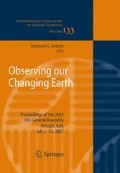Abstract
In order to assess the contribution of non-tidal oceanic mass changes to polar motion, equatorial oceanic excitation functions are determined from combinations of space geodetic techniques and ocean data. Satellite altimetry provides accurate information on sea level anomalies (SLA) which are caused by mass and volume changes of seawater. Since Earth rotation is solely affected by mass variations the volume (steric) effect has to be reduced from the observations in order to infer oceanic contributions to Earth rotation. Oceanic polar motion excitations from reduced SLA are compared with respective results from ocean models. Contributions of ocean currents, atmospheric and hydrological effects are added in order to validate the oceanic excitations from altimetry with independent geodetic observations which reflect the integral effect of a multitude of geophysical processes in the Earth system. This requires an investigation of accuracy and consistency of the combined data sets. The study reveals that model-only combinations of atmospheric, oceanic and hydrological excitations agree better with geodetic observations than combinations which include excitations from altimetry. Possible reasons could be errors in the steric reduction of SLA and/or the compensation of erroneous patterns in atmosphere data by numerical ocean models
Access this chapter
Tax calculation will be finalised at checkout
Purchases are for personal use only
Preview
Unable to display preview. Download preview PDF.
References
Antonov, J.I., R.A. Locarnini, T.P. Boyer et al. (2006). World Ocean Atlas 2005. Volume 2: Salinity. S. Levitus, Ed. NOAA Atlas NESDIS 62, U.S. Government Printing Office, Washington, D.C., pp. 182
Chambers, D.P. (2006). Observing seasonal steric sea level variations with GRACE and satellite altimetry. J. Geophys. Res., 111, 10.1029/2005JC002914
Chen, J.L., C.R. Wilson, R.J. Eanes et al. (2000). A new assessment of long-wavelength gravitational variations. J. Geophys. Res., 105, 0148-0227/00/2000JB900115
Fofonoff, N.P. and R.C. Millard (1983). Algorithms for computation of fundamental properties of seawater. Unesco Technical Papers in Marine Science, 44
Gross, R.S. (1992). Correspondence between theory and observations of polar motion. Geophys. J. Int., 109, pp. 162–170
Gross, R.S. (2007). Earth rotation variations – long period. in: Treatise on Geophysics, Volume 3 – Geodesy, Elsevier, in press
Gross, R.S., I. Fukumori, and D. Menemenlis (2005). Atmospheric and oceanic excitation of decadal-scale Earth orientation variations. J. Geophys. Res., 110, B09405
Ishii, M., M. Kimoto, K. Sakamoto et al. (2006). Steric sea level changes estimated from historical ocean subsurface temperature and salinity analyses. J. Oceanography, 62, pp. 155–170
Kalnay, E., M. Kanamitsu, R. Kistler et al. (1996). The NCEP/NCAR 40-year reanalysis project. Bull. Amer. Meteor. Soc., 77, pp. 437–471
Locarnini, R.A., A.V. Mishonov, J.I. Antonov et al. (2006). World Ocean Atlas 2005. Volume 1: Temperature. S. Levitus, Ed. NOAA Atlas NESDIS 61, U.S. Government Printing Office, Washington, D.C., pp. 182
Milly, P.C.D and A.B. Shmakin (2002). Global modeling of land water and energy balances Part I: the land dynamics (LaD) model. J. Hydrometeorology, 3, pp. 283–299
Thomas, M., J. Sündermann and E. Maier-Reimer (2001). Consideration of ocean tides in an OGCM and impacts on subseasonal to decadal polar motion excitation. Geophys. Res. Lett., 28(12), pp. 2457–2460
Zhou, Y.H., D.A. Salstein and J.L. Chen (2006). Revised atmospheric excitation function series related to Earth’s variable rotation under consideration of surface topography. J. Geophys. Res., 111, 10.1029/2005JD006608
Author information
Authors and Affiliations
Editor information
Editors and Affiliations
Rights and permissions
Copyright information
© 2009 Springer-Verlag Berlin Heidelberg
About this paper
Cite this paper
Göttl, F., Seitz, F. (2009). Contribution of Non-Tidal Oceanic Mass Variations to Polar Motion Determined from Space Geodesy and Ocean Data. In: Sideris, M.G. (eds) Observing our Changing Earth. International Association of Geodesy Symposia, vol 133. Springer, Berlin, Heidelberg. https://doi.org/10.1007/978-3-540-85426-5_53
Download citation
DOI: https://doi.org/10.1007/978-3-540-85426-5_53
Publisher Name: Springer, Berlin, Heidelberg
Print ISBN: 978-3-540-85425-8
Online ISBN: 978-3-540-85426-5
eBook Packages: Earth and Environmental ScienceEarth and Environmental Science (R0)

